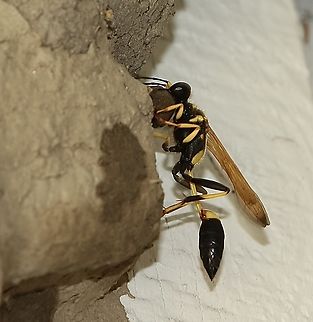
Naming
There are some 30 other species of "Sceliphron" that occur throughout the world, though in appearance and habits they are quite similar to "S. caementarium". "S. caementarium" is widespread in Canada, the United States, Central America, South Africa and the West Indies, and has been introduced to many Pacific Islands, Peru and Europe, where it has become established in the western Mediterranean Basin.
Behavior
The black and yellow mud dauber's nest comprises a series of cylindrical cells that are plastered over to form a smooth nest that may attain nearly the size of a human fist. After building a cell, the female wasp captures several spiders. The captured prey are stung and paralyzed before being placed in the nest, and then a single egg is deposited on the prey within each cell. The wasp then seals the cell with mud. After finishing a series of cells, she leaves and does not return. Eventually, the hatching larva will eat the prey and emerge from the nest. A common species of cuckoo wasp, "Chrysis angolensis", is frequently a cleptoparasite in "Sceliphron" nests, and is only one of many different insects that parasitize these mud daubers.References:
Some text fragments are auto parsed from Wikipedia.